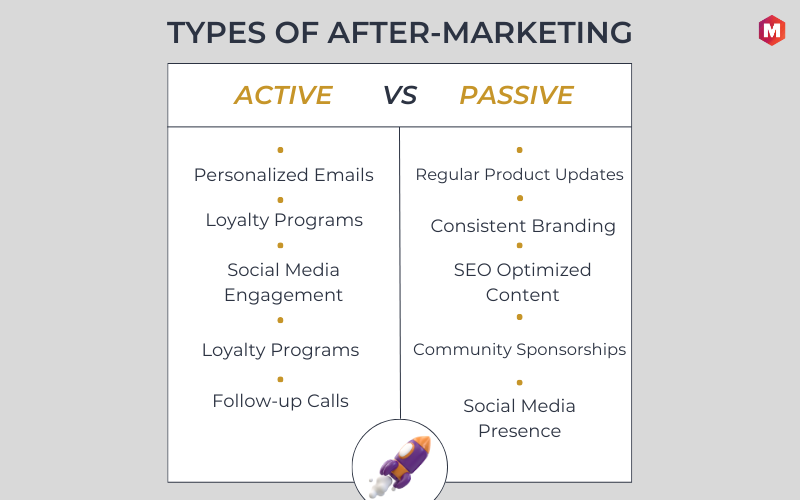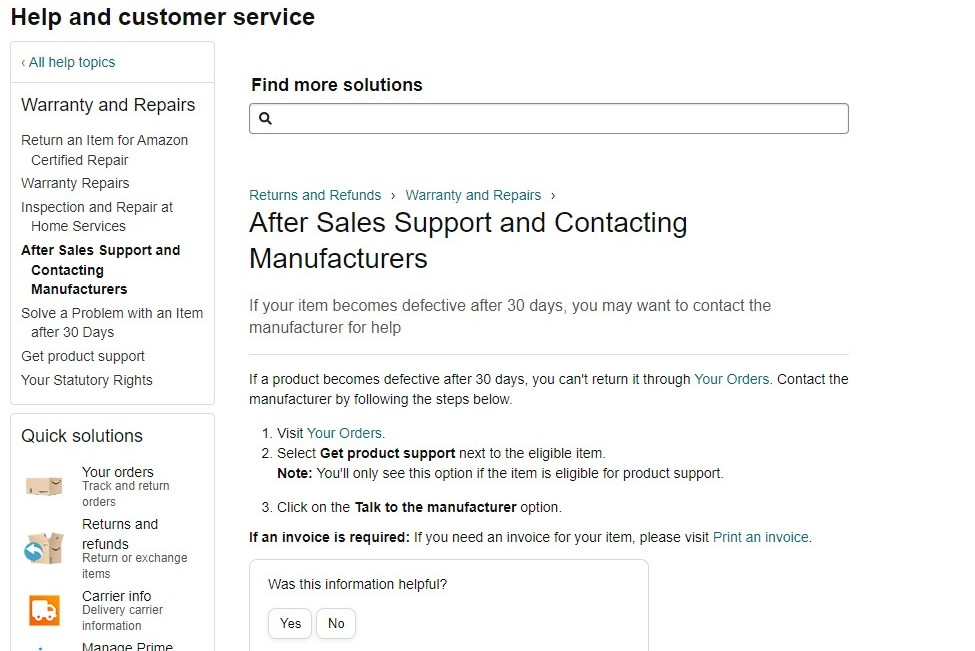Table of Contents
What is After-Marketing?
After-marketing, often called post-sales marketing, is a strategy focused on providing continuous support and value to a customer who has already made a purchase. It involves fostering an ongoing relationship with the customer, intending to promote repeat business, loyalty, and customer satisfaction.
To put it in simpler terms, let’s consider a few instances:
- A software company providing periodic updates and enhancements to their product, ensuring the customer always has the latest features.
- A car dealership offering regular service check-ups for vehicles sold, making sure the customer’s vehicle remains in top-notch condition.
- A clothing brand sending personalized style recommendations based on past purchases, creating a tailored shopping experience for the customer.
Key Takeaways!
- Ongoing communication through after-marketing helps foster customer loyalty, turning one-time buyers into repeat customers.
- After-Marketing can significantly boost customer retention rates, leading to increased revenue.
- It demonstrates a company’s commitment to customer satisfaction, enhancing its reputation.
Importance
Understanding the importance of marketing after sales is crucial for businesses that want to maintain a strong base of loyal customers. This strategy not only reinforces customer satisfaction but also opens up opportunities for up-selling and cross-selling.
Some of the reasons behind using marketing after sales are:
- Customer Retention: It helps retain existing customers by consistently providing value even after the initial purchase.
- Customer Satisfaction: Regular interaction with customers ensures their concerns are addressed, promoting higher satisfaction rates.
- Repeat Business: Satisfied customers are more likely to make additional purchases or renew contracts.
- Referrals: Happy customers often refer friends and family, thereby bringing in potential consumers.
- Brand Loyalty: It can establish a strong emotional connection with customers, fostering brand loyalty.
Types
1) Active After-Marketing Activity
It involves deliberate, proactive strategies designed to maintain and strengthen relationships with customers. These activities are typically observable and directly engage customers.
- Personalized Emails: Tailoring messages to each customer’s history and preferences can make them feel valued and understood.
- Loyalty Programs: Rewarding regular customers with points or perks can encourage repeat business.
- Social Media Engagement: Actively posting updates and responding to customer comments on social media platforms can foster a sense of community.
- Customer Surveys: Asking customers for feedback shows you value their opinions and can provide valuable insights for improvement.
- Follow-up Calls: Checking in with customers after a purchase can ensure satisfaction and address any issues promptly.
2) Passive After-Marketing Activity
It refers to less direct, more subtle techniques that still maintain communication with customers. While less visible, these strategies can also have a significant impact on customer satisfaction and loyalty.
- Regular Product Updates: Providing regular updates keeps your product relevant and shows customers you’re continuously improving.
- Consistent Branding: Maintaining a consistent image across all touchpoints can increase brand recognition and loyalty.
- SEO Optimized Content: Regularly updating your website with SEO-optimized content can keep your brand in front of customers.
- Community Sponsorships: Supporting local events or charities can improve your brand image and show customers you care about more than just profit.
- Social Media Presence: Even if you’re not regularly posting, having a presence on social media platforms gives customers a place to engage with your brand.
Best Strategies
Here are some of the good after-marketing activities you can employ to enhance your marketing efforts once sales have been completed:
- Social Media Marketing Campaigns: Launch innovative and engaging campaigns on social marketing sites to capture consumers’ interest and foster a strong brand connection.
- Customer Service Support: Making the sales department readily available to address questions and concerns boosts consumer loyalty and satisfaction, increasing the likelihood of repeat sales.
- Tailored After-Marketing Activities: Implement personalized follow-ups based on the consumer’s purchase history to show them you understand and cater to their unique needs.
- Loyalty Reward Programs: Enhance your existing loyalty programs with exciting rewards and exclusive benefits to incentivize repeat purchases and customer referrals.
- Post-Purchase Surveys: Request feedback through post-purchase surveys to understand areas that require service support, thus continually improving the customer experience.
How After-Sales Service Works in Marketing?
After-sales service forms a critical component of effective marketing strategies. It involves an active effort from businesses to maintain a strong relationship with customers post-purchase. The main goal is to ensure customer satisfaction and foster brand loyalty. Some of the ways through which after-sales service works are:
- Product Training: Offer comprehensive product training to help customers get the most out of their purchases.
- Technical Support: Offer reliable technical support to troubleshoot any product-related issues that may arise.
- Maintenance Services: Provide regular maintenance services to keep the product in optimal condition.
- Warranty and Replacement: Ensure transparent and hassle-free warranty and replacement services.
- 24/7 Customer Support: Establish a round-the-clock customer support system to address any queries or concerns promptly.
Example of Amazon After-Sales Marketing
Amazon’s marketing after-sales activities are customer-centric such as:
- They use personalized recommendations based on a customer’s browsing and purchasing history to enhance user experience and increase sales.
- Their customer service is available 24/7, resolving any concerns or product-related issues promptly.
- They also offer a transparent and easy return policy, ensuring customer satisfaction and trust in their services.
FAQs
1) What is the difference between After Marketing and Contribution Margin After Marketing (CMAM)?
A: After Marketing refers to the activities a company undertakes to maintain and strengthen relationships with existing and potential consumers post-purchase. On the other hand, CMAM is a financial metric that shows a product’s profitability after accounting for variable costs and marketing expenses.
2) How to define after-marketing activities?
A: Marketing after-sales activities are efforts deployed by businesses post-sale to ensure customer satisfaction, foster loyalty, and develop long-term relationships. These may include customer service, maintenance services, technical support, and personalized marketing.
3) What is the role of after-sales support?
A: After-sales support plays a crucial role in customer satisfaction and brand loyalty. It involves addressing any product-related issues, providing maintenance services, offering product training, and handling returns or replacements, enhancing the overall customer experience after the purchase.
Liked this post? Check out the complete series on Sales

